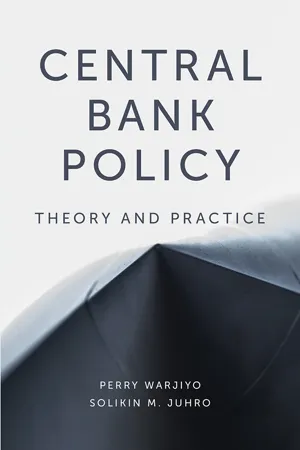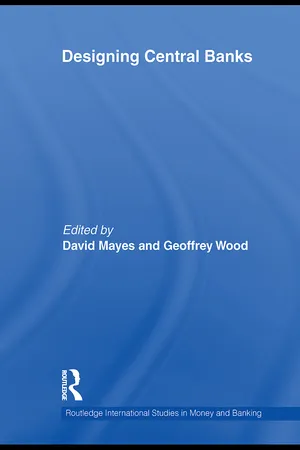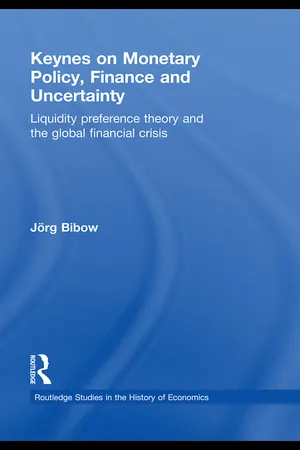Economics
Central Bank Independence
Central bank independence refers to the degree of autonomy a central bank has from the government in making monetary policy decisions. An independent central bank is able to make decisions based on economic considerations rather than political pressures, which can lead to more stable and predictable monetary policy. This independence is often seen as important for maintaining price stability and controlling inflation.
Written by Perlego with AI-assistance
Related key terms
5 Key excerpts on "Central Bank Independence"
- eBook - ePub
Central Bank Policy
Theory and Practice
- Perry Warjiyo, Solikin M. Juhro(Authors)
- 2019(Publication Date)
- Emerald Publishing Limited(Publisher)
Chapter 10 explained that time-consistent and rule-based policy responses are crucial to build central bank policy credibility. Central Bank Independence, as described in this chapter, represents a form of learning the authority to achieve the price structure mandate of a competent central bank that can implement its duties and guarantee the partnership between policy and setting the rules. Meanwhile, accountability is the logical consequence of independence in pursuance of the mandate. In other words, policy consistency, including rule-based policy, independence, and accountability are all vital to build central bank policy credibility.Relating to the principles of independence, providing a mandate of independence to the central bank, accompanied by accountability, is required ensure the effectiveness of policies to achieve the final target of professional integrity. Referring to the experiences of various countries and the underdeveloped political conditions in developing countries (typically applying a multi-party political system), Central Bank Independence is necessary to subdue the interests of the elite that are counterproductive to the attainment of sustainable economic growth.Although the legal facts show that Central Bank Independence has been set proportionally in prevailing laws, implementation must be observed in the context of integrated policy coordination. This implies that the central bank’s policy cannot run by itself. On one hand, central bank policy is determined as the manifestation of autonomous professionalism. On the other hand, however, the institutional and political constellation, which is oriented toward improving public welfare, requires that the central bank not be sterile to the political process altogether. To that end, central bank policy implementation must be strengthened by harmonious policy coordination between the central bank and government or other relevant stakeholders.The critical importance of policy coordination becomes even more apparent during crisis conditions. Numerous aspects change and problems emerge during a crisis, therefore central bank policy independence could be interpreted narrowly as impossible and undesirable. Consequently, independence must encompass the broader interests through policy coordination between the central bank and government to jointly overcome the crisis. Nonetheless, after the crisis period has been overcome, the central bank must prudently extricate itself from the policy compromise with the government and gradually rebuild its independence. - eBook - ePub
- Miroslav Beblavý(Author)
- 1998(Publication Date)
- Routledge(Publisher)
The second column contains the mean of these values and the third the standard deviation. The fourth column contains the mean of the responses of central banks from industrialised countries, and the difference between the mean values for central banks in transition and industrialised countries is in the last column. Central bankers in Central Europe feel very strongly about four particular elements of Central Bank Independence. 3 Generally, surveyed central bankers from transition countries gave ten to these criteria, suggesting the strength of consensus. Their view is also shared by the central bankers from industrialised countries based on Masciandaro and Spinelli (1994). First of all, no governmental approval of monetary policy should be required. This criterion can be roughly identified with goal independence, the ability of the central bank to set the final goals of monetary policy (Debelle and Fischer 1995). Second, the central bank should set discount and other major interest rates. This criterion, on the other hand, can be approximately identified with instrument independence (freedom to choose means to achieve a given monetary policy end (Debelle and Fischer 1995)). Third, there should be restrictions on central bank credit to government. This comprises four criteria of economic independence concerning duration, amount, interest rate and automatic nature of central bank credit to the government. And finally, the central bank should not be active in the primary market for government debt - eBook - ePub
- Heinz Herrmann, David Mayes, Geoffrey E Wood(Authors)
- 2009(Publication Date)
- Routledge(Publisher)
de jure as well as de facto independence and generally used its independence to promote public support for price stability. In spite of this long-term position the Bundesbank’s policy occasionally responded to the electoral cycle. Vaubel (1997) shows that monetary expansion accelerated at the beginning of pre-election periods when the German government had a political majority at the Bundesbank council and that it decelerated when the reverse was true.3 In a few cases such as the ECB and the Banco Central de Chile, the bank is even given some limited goal independence in the sense that it is free to determine its own inflation target.4 For reasons of space I do not discuss the fast-expanding literature on those topics. The March 2007 issue of the European Journal of Political Economy is devoted to CB transparency and communications.5 Previous surveys appear in Eijffinger and de Haan (1996) and in Berger et al. (2001).6 Although related independence and conservatism are not quite the same. Independence refers to the ability of the bank to implement the policies it desires without political interference. Conservatism refers to the importance that the bank assigns to price stability in comparison to real objectives like high levels of economic activity and employment. Obviously, effective conservatism, which determines policy choices, depends both on the bank’s conservatism, as well as on its independence. For the purposes of this survey there is no need to distinguish between those two concepts. I therefore use the terms conservatism and independence interchangeably to mean ‘effective conservatism’. However, there are contexts in which it is useful to keep conservatism and independence apart (Eijffinger and Hoebericht, 1998). - Robert B. Packer(Author)
- 2018(Publication Date)
- Routledge(Publisher)
But even controlling for budget deficits, independent central banks are less expansionary. To some extent this is due to a traditional, and often statutory, function of the central bank to protect the value of the currency. But it is also because more independent banks are often closely aligned with the financial sector (e.g., in the United Kingdom, the United States, and Switzerland). Alesina and Summers (1993) note that by “delegating monetary policy to an agent whose preferences are more inflation-averse than are society’s preferences serves as a commitment device that permits sustaining a lower rate of inflation than would otherwise be possible. By contrast, less independent banks are more closely associated with society’s preference for expansionary policies, as expansion helps to fulfill traditional objectives of full employment and high social expenditures. Both econometric research (Epstein and Schor, 1985), as well as two case studies of central bank movements toward independence (the Federal Reserve in 1951, and the Banca ďItalia in 1981), strongly support the view that independent central banks are more restrictive. Third, international financial integration, along with the creation of new financial instruments, is said to have blunted the effectiveness of monetary and fiscal tools, so that changes in interest rates or government borrowing have a smaller impact on the economy. Even within the field of macroeconomic theory, new approaches were developed that argued that state intervention in the economy was irrelevant, if not counterproductive. The new theoretical models drew heavily on rational-expectations hypothesis. Models based on rational expectations implied that, once individuals became aware of the authorities’ determination to reduce inflation, they would incorporate this information into their expectations and adjust their behavior accordingly- Jorg Bibow(Author)
- 2013(Publication Date)
- Routledge(Publisher)
6 Keynes on central banking and the structure of monetary policy1John Maynard Keynes’ monetary works, from A Tract on Monetary Reform to A Treatise on Money and The General Theory, are well known for their insights into the functioning of monetary economies and the conduct of monetary policy in such a world, i.e. the appropriate goals of, and ways to implement, monetary policy. Less well known is that Keynes also thought carefully about the appropriate structure of monetary policy: the regulation of central banks in general and their relation to the state in matters of monetary policy.In fact, in recent years discussions in monetary economics have often concentrated on the structure rather than the conduct of monetary policy. The notion of “Central Bank Independence” in particular has received enormous popular attention as well as scientific support from a literature dealing with the so-called time-inconsistency problem allegedly afflicting “discretionary” arrangements in monetary policy.2 While the notion of Central Bank Independence is clearly meant to capture some elements of the relation between the central bank and the state implicitly held to be essential in solving the alleged time-inconsistency problem, it is often not made clear what the crucial responsibilities of an independent central bank exactly should be, and how and to whom it should be held to account on its performance. Yet it would seem to be of little use to claim anything for “independence” as such, and it may even be positively misleading to sell independence as a free lunch, when what really matters is the precise form and degree of independence.It is thus of some interest that Keynes in 1932 provided an outline of a particular form and degree of independence that he thought would promote efficiency in the conduct of monetary policy and allow ultimate democratic control over policy to be retained at the same time. The analysis of Keynes’ proposal of 1932 for a sound structure of monetary policy will be our main objective here.
Learn about this page
Index pages curate the most relevant extracts from our library of academic textbooks. They’ve been created using an in-house natural language model (NLM), each adding context and meaning to key research topics.




